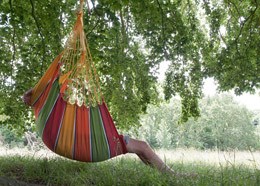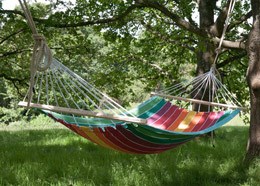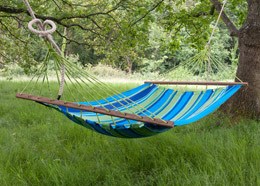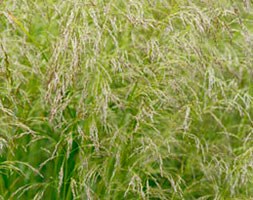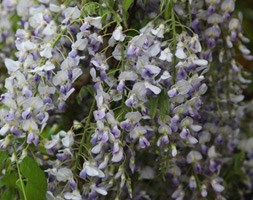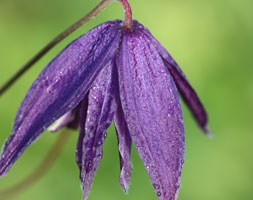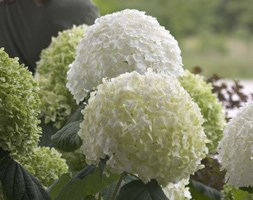New products at Crocus
by Sarah - June 13th, 2014.Filed under: Crocus, New Products.
Crocus has these new items today
Swing hammock chair – tutti fruiti £89.99
This colourful chair swing will provide hours of relaxation in the garden. This attractive hammock provides a cosy and comfy space for you to sit back and enjoy all your hard work this Spring. They are all completely handmade with each and every stitch of the crochet hammocks being made in El Salvador by artisans, who try to keep their culture alive by applying traditional production techniques. The swing chair hangs from a single point and can be hung from a tree limb or simply a garden arbour beam so long as the hardware and handing strings are strong enough to hold the weight of the person using it. Please note the approx. capacity of the swing hammock is 120kg but please make sure secure and strong before use. How to hang the chair swing: Tree limb: loop a heavy rope or chain over a sturdy tree limb and attach the swing to the rope or chain with an ‘s’ hook or threaded quick link. Please note: The swing chair will stretch slightly when you sit on it. Keep this in mind when determining the height to install the swing from the floor to the ground. Although these fabrics are mildew and fade resistant, avoid it’s prolonged exposure to sunlight and rain. Over time, this would weaken the fabric and strings. When not in use, we suggest your bring the hammock indoors. Dry thoroughly before storage. Please note: rope and fixings not included.
Swing hammock with bars – Rio de janeiro £69.99
This bright and colourful hammock will provide hours of relaxation in the garden. This attractive hammock provides a cosy and comfy space for you to sit back and enjoy all your hard work this summer. These hammocks are all completely handmade with each and every stitch of the crochet hammocks being made in El Salvador by artisans, who try to keep their culture alive by applying traditional production techniques. Also comes complete with matching pillow cover. This string hammock with bars can be hung from between two trees, posts or garden wall so long as the hardware and hanging strings are strong enough to hold the weight of the person using it. Please note the approx. capacity of the swing hammock is 120kg but please make sure secure and strong before use. How to hang the string hammock: Between two trees or posts: tie a strong rope around the tree, make a knot, then reach the hammock’s eye and make another knot. Ideally, supports, posts or trees should be 25-30cm further apart than the length of the hammock. Prior to using your hammock please check all knots are tight and secure and carefully sit in it to make sure it has been installed properly. Although these fabrics are mildew and fade resistant, avoid it’s prolonged exposure to sunlight and rain. Over time, this would weaken the fabric and strings. When not in use, we suggest your bring the hammock indoors. Dry thoroughly before storage. Hand washable with mild soap. Please note: rope and fixings not included.
Swing hammock with bars – rainbow £69.99
This bright and colourful hammock will provide hours of relaxation in the garden. This attractive hammock provides a cosy and comfy space for you to sit back and enjoy all your hard work this summer. These hammocks are all completely handmade with each and every stitch of the crochet hammocks being made in El Salvador by artisans, who try to keep their culture alive by applying traditional production techniques. Also comes complete with matching pillow cover. This string hammock with bars can be hung from between two trees, posts or garden wall so long as the hardware and hanging strings are strong enough to hold the weight of the person using it. Please note the approx. capacity of the swing hammock is 120kg but please make sure secure and strong before use. How to hang the string hammock: Between two trees or posts: tie a strong rope around the tree, make a knot, then reach the hammock’s eye and make another knot. Ideally, supports, posts or trees should be 25-30cm further apart than the length of the hammock. Prior to using your hammock please check all knots are tight and secure and carefully sit in it to make sure it has been installed properly. Although these fabrics are mildew and fade resistant, avoid it’s prolonged exposure to sunlight and rain. Over time, this would weaken the fabric and strings. When not in use, we suggest your bring the hammock indoors. Dry thoroughly before storage. Hand washable with mild soap. Please note: rope and fixings not included.
Swing hammock with bars – blue £69.99
This bright and colourful hammock will provide hours of relaxation in the garden. This attractive hammock provides a cosy and comfy space for you to sit back and enjoy all your hard work this summer. These hammocks are all completely handmade with each and every stitch of the crochet hammocks being made in El Salvador by artisans, who try to keep their culture alive by applying traditional production techniques. Also comes complete with matching pillow cover. This string hammock with bars can be hung from between two trees, posts or garden wall so long as the hardware and hanging strings are strong enough to hold the weight of the person using it. Please note the approx. capacity of the swing hammock is 120kg but please make sure secure and strong before use. How to hang the string hammock: Between two trees or posts: tie a strong rope around the tree, make a knot, then reach the hammock’s eye and make another knot. Ideally, supports, posts or trees should be 25-30cm further apart than the length of the hammock. Prior to using your hammock please check all knots are tight and secure and carefully sit in it to make sure it has been installed properly. Although these fabrics are mildew and fade resistant, avoid it’s prolonged exposure to sunlight and rain. Over time, this would weaken the fabric and strings. When not in use, we suggest your bring the hammock indoors. Dry thoroughly before storage. Hand washable with mild soap. Please note: rope and fixings not included.
Deschampsia cespitosa ‘Goldschleier’ (tufted hair grass) £19.99
Position: full sun or partial shade Soil: dry to moist, neutral to acid soil Rate of growth: average to fast-growing Flowering period: June to August Flower colour: bright silvery yellow Hardiness: fully hardy A beautiful tuft-forming, evergreen grass that will help add structure and movement to the border. In summer the dark green leaves are topped with airy flower spikelets that turn a bright silvery yellow as they age. This airy grass looks lovely in a mixed border where it will waft hazily in the breeze. Relatively compact and easy-to-grow, it will flourish in neutral to acidic soil. Garden care: Remove the faded flower-heads in late winter before new growth appears. If the foliage has also started to look tatty at that time of the year, then this too can be cut back hard. In warm areas the plant has a tendency to self-seed freely. Where this is the case remove unwanted seedlings as part of routine border maintenance.
Wisteria floribunda ‘Domino’ (japanese wisteria syn ( Wisteria ‘Issai )) £19.99
Position: full sun or light, dappled shade Soil: fertile, moist, well-drained soil Rate of growth: fast-growing Flowering period: June Flower colour: lilac-blue Other features: velvety, green seed-pods in hot summers; all parts of the plant are harmful if ingested Hardiness: fully hardy From early summer, fragrant lilac-blue flowers open gradually from the base of the pendulous racemes that form on this vigorous, deciduous climber. All the Wisterias we sell are grafted, so will start to flower at a younger age than those grown from cuttings. Garden care: To get lots of flowers, the twining stems need pruning twice a year – once in summer (about two months after the flowering has finished) and again in mid-winter. To train your Wisteria against a wall, the wall will first need a network of stout horizontal wires, attached at approximately 30cm intervals. After planting, prune the leading shoot of your Wisteria back to approximately 90cm above ground level and remove any side branches as this will encourage a strong new leader to form. In the summer of the first growing season, tie the leader in vertically and choose two new lateral shoots on either side of the leader. Tie these onto the wires at a 45 degree angle. Any smaller shoots coming from these lateral branches should be cut back to two or three buds. In the first winter, cut back the leader to a bud approximately 75cm above the highest lateral branch. Gently untie the lateral branches and prune them back by about a third, then re-tie them onto a wire so they are nearly horizontal. In subsequent summers (and until the plant has filled the allotted space), tie in the leader as it grows and choose two strong laterals to form the next tier. These should then be tied in at a 45 degree angle and as in the previous year, any smaller shoots coming from these should be cut back to two or three buds. In subsequent winters cut back the leading shoot as before and cut back and re-tie the new laterals to a near-horizontal position. The older laterals can be cut back by about a third of their total length. Once the plant has become established and reached the desired height, keep tying in the lateral stems as they spread out. In summer, cut back the wispy stems on both the laterals and sub-laterals (the side shoots from the laterals) to about five or six buds from the main branches. In winter, cut back these stems even harder to within two or three buds of the main bran
Clematis ‘Purple Spider’ (clematis (group 1)) £17.99
Position: full sun or partial shade Soil: fertile, moist, well-drained soil Rate of growth: average Flowering period: April to June and sometimes again in August Flower colour: deep purple Hardiness: fully hardy The nodding, deep purple, spider-like flowers appear in mid spring to early summer, and occasionally have a second flush in late summer. These are followed by attractive, silky seedheads, which can last until autumn. Its compact habit makes it ideal for pots and containers. Garden care: No routine pruning is necessary. If the spread of the plant needs to be restricted prune immediately after flowering, cutting back overlong shoots to healthy buds. Apply a slow-release balanced fertiliser and a mulch of well-rotted garden compost around the base of the plant in early spring.
Jasminum polyanthum (scented Chinese jasmine on a hoop) £14.99
One of the photos on this page shows the plant with gift wrap. This is not included in the price, however you may add gift wrap (for an additional charge of £4.95) during the order process. Position: sun to part shade Soil: moist, well-drained soil Rate of growth: average Flowering period: April – May Hardiness: tender (will need winter protection) A vigorous twining climber with attractive dark, glossy evergreen leaves. The real attraction though are the masses of highly scented star-shaped white flowers that open from pink buds. A good choice for covering the wall of an unheated conservatory, or for smothering a wigwam of canes set into a pot. When grown inside in a warm conservatory they flower from late winter, but in colder temperatures the flowers appear from spring to summer. Garden care: Grow in a pot on a sunny patio with shade from midday sun during the summer, and move to a protected spot with a minimum temperature of 10C during the winter. Feed every two weeks during the growing season with a balanced liquid fertiliser. Prune to fit the growing frame in late winter or early spring.
Hydrangea arborescens Strong Annabelle (‘Abetwo’) (sevenbark ( Incrediball )) £11.99
Position: full sun or partial shade Soil: moist, well-drained, moderately fertile, humus-rich soil Rate of growth: average Flowering period: July to September Hardiness: fully hardy This recently introduced Hydrangea has tougher branches than many of the other arborescens types, which means that as they mature they will stand up better in more exposed positions and will rarely flop over when laden with flowers. The glorious bundles of white flowers will also get larger as the plant grows older, but even when they are still quite young, they will put on a dazzling and long-lasting display from mid summer. Garden care: In hot weather, thoroughly soak the plants roots when watering to prevent it drying out. Remove faded flowerheads in spring after the danger of frosts, cutting back the flowered stems to a strong pair of buds and take out misplaced or diseased shoots. Once established, remove a quarter to a third of the shoots to the base of the plant. Cutting it back in this way will keep it compact and will also result in a branching, bushier shrub. Mulch young plants with a well-rotted manure or compost in spring.







